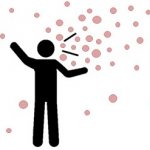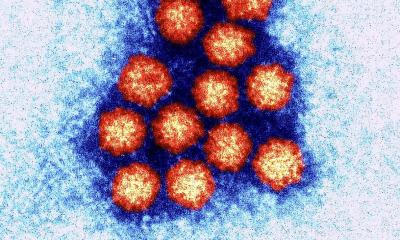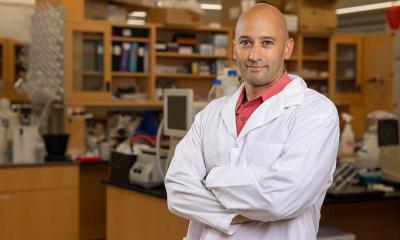Image source: Pexels/Anastasia Shuraeva
News • Droplet spread simulation
Mathematical model to predict the spread of airborne diseases
A new mathematical model is helping develop the current understanding of how airborne diseases such as COVID-19 can spread during breathing and aerosol generating procedures.
Researchers from Heriot-Watt University and the University of Edinburgh have developed a mathematical model of droplet migration. Dr Cathal Cummins of Heriot-Watt’s School of Mathematical and Computer Sciences and Institute for Infrastructure and Environment, devised a mathematical model of droplet spread and found a clear demarcation between small, intermediate, and large-sized droplets. By using simple formulas he and the team were able to determine a droplet’s maximum range.
The research has been published in the fluid mechanics journal Physics of Fluids.
Recommended article

News • Airborne droplet travel distance
Why you shouldn't underestimate the reach of COVID-19
A plea issued by 239 scientists from around the world to recognise and mitigate airborne transmission of COVID-19 addressed to international health authorities is published in the journal Clinical Infectious Diseases. Led by internationally recognised air quality and health expert Professor Lidia Morawska from Queensland University of Technology (QUT), the appeal is to address the overwhelming…
While this model predicted large and small droplets can spread far, which is in agreement with previous studies, the authors found, unexpectedly, that medium-sized droplets fall very close to the source. This phenomenon had been previously observed in experiments with people breathing, where it was explained to arise from the way a person breathes. However, the model shows for the first time, this could be explained by physics rather than only by physiology.
The findings follow the World Health Organisation’s warning that aerosol transmission of COVID-19 is being underestimated. If aerosol spread is confirmed to be significant, as suspected, then governments may need to reconsider guidelines on social distancing, ventilation systems, and shared spaces. But before this step is taken, researchers say the science community needs a better understanding of how droplets behave when travelling through the air and their different dispersion mechanisms based on droplet size.
Dr Cathal Cummins, who is leading the research from Heriot-Watt University, said: “The flow physics of someone coughing is complex, involving turbulent jets and droplet evaporation and the rise of COVID-19 has revealed the gaps in our knowledge of the physics of transmission and mitigation strategies. “One such gap in the physics is a clear, simple description of where individual droplets go when ejected. We wanted to develop a mathematical model of someone breathing that could be explored analytically to examine the dominant physics at play.”
As a person breathes, they emit droplets of various sizes that don’t necessarily follow the airflow faithfully. Dr Cummins continues: “We represent breathing as a point source of both air and droplets, and include a point sink to model the effect of extraction of air and droplets. To take their size and density differences into account, we use the Maxey-Riley equation, which describes the motion of a small but finite-sized rigid sphere through a fluid.”
Larger droplets would be easily captured by PPE, such as masks and face shields. But smaller droplets may penetrate some forms of PPE
Cathal Cummins
This work gives researchers a general framework to understand the dispersion of droplets. “A big surprise for us was when we found that both small and large droplets travel far from the source, albeit for very different reasons,” continued Dr Cummins. “But there are medium-sized droplets that don’t get far at all. This had been previously observed in experiments with people breathing, but the bimodality was typically attributed to a biological function.”
The simplicity of this model demonstrates that bimodality could actually be a property of the droplets themselves, and the group provides formulas to predict when such droplets will have short ranges. “Our study shows that there isn’t a linear relationship between droplet size and distance travelled—with both small and large droplets traveling further than medium-sized ones,” said Dr Felicity Mehendale, co-author and academic surgeon at the University of Edinburgh. “We can’t afford to be complacent about these small droplets. PPE is an effective barrier to large droplets, but may be less effective for small droplets.” As a solution, Dr Mehendale came up with the idea of creating an aerosol extractor device. The team are working on plans to manufacture the aerosol extractor to keep clinicians safe during a wide range of aerosol generating procedures (AGPs) routinely performed in medicine and dentistry.
Extraction units placed close to the sources of droplets can effectively trap them, as long as the droplet diameters are less than about that of a human hair. “This has important implications for the COVID-19 pandemic,” said Dr Cummins. “Larger droplets would be easily captured by PPE, such as masks and face shields. But smaller droplets may penetrate some forms of PPE, so an extractor could help reduce the weakness in our current defence against COVID-19 and future pandemics.”
A better understanding of the behaviour of droplets will help “inform the safety guidelines for aerosol generating procedures,” Dr Mehendale said, “and it will be relevant during the current and future pandemics, as well as for other infectious diseases. This mathematical model may also serve as the basis of modelling the impact on droplet dispersion of different ventilation systems that exist within a range of clinical spaces.”
Source: Heriot-Watt University
10.08.2020











